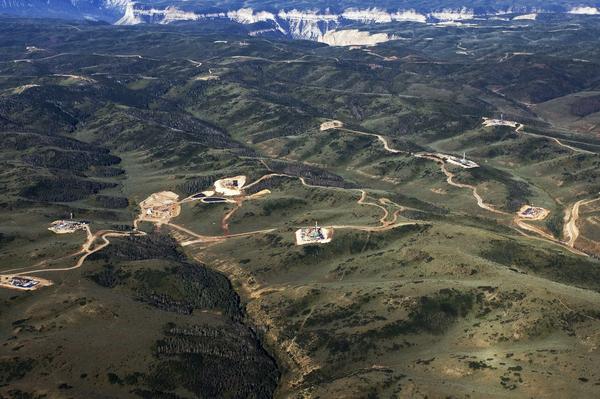
While we’ve been having this discussion about settlements, I’ve been thinking a couple of things and following the newspaper on oil and gas in Colorado.
Let’s say there is way “a” of looking at things. NGOs have policy objectives. Litigating on NEPA, NFMA and ESA is a way of meeting those objectives. NEPA is convenient because you can find holes if you are smart and careful enough. This can delay people or make them give up, or negotiate with you, or if you wait long enough the material can lose its value, or the price of say, coal, can be too low and the project will not happen. NEPA claims seem to be used as a tool to delay or stop projects or make plans more in line with the plaintiff’s views.
Way “b” is articulated by others on this blog better than I, but is along the lines of “the FS does not follow the “rules” and NGO’s make them enforce the rules (related to the environment). Environmental impacts are said to depend on the intensity of impact, the frequency and the area impacted, so I am curious why some NGO’s choose the projects they do to worry about enforcing the rules. For example, hazard tree projects are a yawn in Colorado and a Big Deal in Montana. It doesn’t seem to me to do with the environmental impacts being all that different, nor the quality of the NEPA documents. So there must be a different explanation.
I thought some comparisons with oil and gas in Colorado might be helpful. Here there is some on the federal estate as well as private. There is no doubt about the value of the jobs and the funds given to communities and states.
First, here is a settlement discussed for the Roan Plateau. Now if the BLM has been working on this for all these years (since way before I retired) it seems like they could have done any NEPA that a judge required. Seems more like “A” to me; see my italics as to those “in the room.” Here’s a link to the story.
A proposed settlement that could free up some oil and gas leases within the Roan Plateau study area for drilling and do away with others should not come at the expense of future mineral lease payments to local governments, Gov. John Hickenlooper has pledged.
“The Hickenlooper administration believes a settlement that allows some energy development to proceed while protecting other areas of the Roan Plateau is in the interest of all parties,” Henry Sobanet, director of Hickenlooper’s Office of State Planning and Budgeting, wrote to state Rep. Bob Rankin.
Rankin, R-Carbondale, has been working with the governor’s office on a deal to prevent future federal mineral lease dollars from being withheld from local entities in order to refund about $28 million to Bill Barrett Corp.
The proposed settlement involving Barrett, environmental groups and the federal government has been touted as a potential “win-win” by those involved.
The exception has been local governments, including Garfield County, which have asked that they be held harmless in the deal.
Of particular concern is the state’s practice of withholding future federal mineral lease dollars, including royalties from producing wells, that normally would be distributed to local governments to help pay for impacts from energy development, instead of asking those entities to refund money that already has been paid out.
The deal could end several years of litigation over natural gas drilling on the Roan Plateau northwest of Rifle, where the U.S. Bureau of Land Management has reopened the federal environmental impact review that led to leases being issued in 2008.
Under the proposed settlement, Barrett would be reimbursed some of its federal leases in the more pristine areas atop the Roan Plateau.
In exchange, Barrett and other lease holders would be allowed to develop less-controversial leases, including in areas that already have active gas wells.
There is also an issue of oil and gas development and regulations for towns and communities. Recently it looked like Governor Hickenlooper tried unsuccessfully to broker a solution. But what was on the table was litigation and legislation. Now, this is under the state’s jurisdiction, hence the legislation alternative. Here’s the link to one story:
At the statehouse news Monday conference, Hickenlooper and Polis outlined the compromise, which involves four steps.
The governor create the commission to make recommendations to the legislature — by a two-thirds vote.
Hickenlooper had tried for months to broker a legislative compromise, but that effort collapsed in July.
“This may be the template for what happens in the rest of the country,” Hickenlooper said, noting similar conflicts are roiling in Texas, Wyoming and Pennsylvania. “This is the way we do things in Colorado. We work through our differences and difficulties. Maybe no one is perfectly happy, but it serves all parties.”
Polis said it was “better to address these issue in rule or by legislation, but if that doesn’t work, you’ve got to go to the ballot box.”
Private land.. many people including diverse representatives of the public need to agree. Public land.. NGO’s Barrett, and the feds need to agree.
I’m not sure I’m getting your point, but I think the difference is more that the public land example involves litigation and litigants, while the private land example is legislation by representative democracy.
I might be concerned about how much the BLM could change the decision being litigated without going back through the public NEPA process. (We don’t have all the facts, but I would say it’s generally ok under NEPA to do less than the original plan and impacts, but maybe not ok to do it in different places than the original plan.)